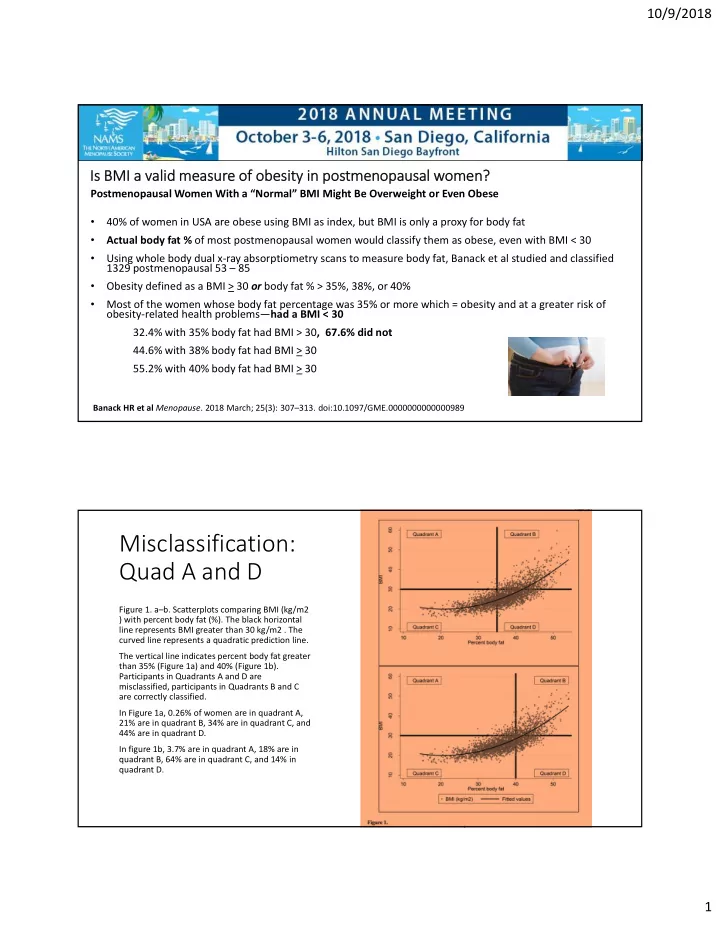

10/9/2018 Is Is BM BMI a valid lid mea measur ure of of obes obesity ity in in postmenopausal postmenopausal wo women? Postmenopausal Women With a “Normal” BMI Might Be Overweight or Even Obese • 40% of women in USA are obese using BMI as index, but BMI is only a proxy for body fat • Actual body fat % of most postmenopausal women would classify them as obese, even with BMI < 30 • Using whole body dual x ‐ ray absorptiometry scans to measure body fat, Banack et al studied and classified 1329 postmenopausal 53 – 85 • Obesity defined as a BMI > 30 or body fat % > 35%, 38%, or 40% • Most of the women whose body fat percentage was 35% or more which = obesity and at a greater risk of obesity ‐ related health problems— had a BMI < 30 32.4% with 35% body fat had BMI > 30 , 67.6% did not 44.6% with 38% body fat had BMI > 30 55.2% with 40% body fat had BMI > 30 Banack HR et al Menopause . 2018 March; 25(3): 307–313. doi:10.1097/GME.0000000000000989 Misclassification: Quad A and D Figure 1. a–b. Scatterplots comparing BMI (kg/m2 ) with percent body fat (%). The black horizontal line represents BMI greater than 30 kg/m2 . The curved line represents a quadratic prediction line. The vertical line indicates percent body fat greater than 35% (Figure 1a) and 40% (Figure 1b). Participants in Quadrants A and D are misclassified, participants in Quadrants B and C are correctly classified. In Figure 1a, 0.26% of women are in quadrant A, 21% are in quadrant B, 34% are in quadrant C, and 44% are in quadrant D. In figure 1b, 3.7% are in quadrant A, 18% are in quadrant B, 64% are in quadrant C, and 14% in quadrant D. 1
10/9/2018 35% cut = 24.8 Defining Obesity: 38% cut = 26.5 40% cut = 27.1 Age Related Shift In Visceral Fat Between 3 rd and 7 th decade • visceral fat ↑ 200% in men, ↑ 400% in women 1. Loss of muscle mass 2. Weight gain 3. Shift in peripheral to central fat pattern pre post pre post Ley. Am J Clin Nutr. 1992; 55(5): 950 ‐ 954 Hunter, Int J Body Composit Res 2010: 103 ‐ 8 2
10/9/2018 Intra ‐ abdominal adiposity closely correlates with abdominal obesity AND waist measurement correlates with intra ‐ abdominal adiposity and risk factors • Hypertriglyceridemia • Insulin resistance • Low HDL • hyperinsulinemia 300 • Elevated apo B • Glucose intolerance IAA (cm 2 ) • Increased small dense LDL • Impaired fibrinolysis 200 • Inflammatory profile • Endothelial dysfunction 100 r = 0.80 IAA 0 60 80 100 120 Waist circumference (cm) To assess IAA, the simplest measure of abdominal obesity is waist circumference, which is strongly correlated with direct measurement of IAA by CT scan or MRI, considered to be the gold standard Lemieux in Kopelman (ed) , Després JP et al, 2001; IAA: intra ‐ abdominal adiposity; CT: computed tomography; Management of obesity and related disorders, Dunitz: 2001. Pouliot MC et al, 2004 MRI: magnetic resonance imaging Lemieux Thromb Vasc Res 2001 Conclusion: Obesity cutoff for menopausal women may be the upper threshold of normal BMI 24.9 If the waist circumference is high, no matter what the BMI is, there will be concerns about cardiovascular risk, diabetes risk, and cardio ‐ metabolic outcomes…. J Manson 3
Recommend
More recommend